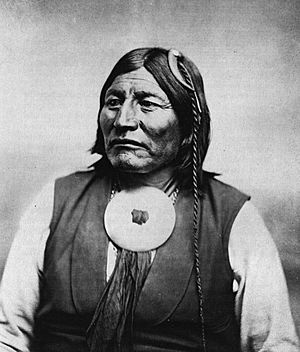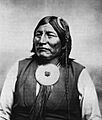Mow-way facts for kids
Quick facts for kids
Mow-way
|
|
|---|---|
 |
|
| Kotsoteka Comanche leader | |
| Personal details | |
| Born | ca. 1825 |
| Died | 1886 |
| Cause of death | Pneumonia |
| Known for |
|
Mow-way (born around 1825, died 1886) was a very important leader and war chief of the Kotsoteka band of the Comanche people. European settlers often called him Shaking Hand or Hand Shaker. He became a main leader in the 1860s and 1870s. This was after other chiefs like Kuhtsu-tiesuat (Little Buffalo) and Tasacowadi (Big Cougar) passed away.
Contents
Adventures in Mexico
In the late 1840s and early 1850s, a group of Kotsotekas traveled into Chihuahua State, Mexico. They were led by Tabe-tipu, a shaman, and her son Tabe-tuhka. Mow-way, who was Tabe-tuhka's son or younger brother, was also with them.
The government in Chihuahua offered money for Native American scalps. This led to intense conflict with various tribes, including the Comanche. In 1851, the Kotsotekas made a deal with the Chihuahuan government. They agreed to help fight the Apache people.
However, the Kotsotekas soon moved into other Mexican states. They did not focus on hunting Apaches. Tabe-tuhka returned to Chihuahua with 400 warriors. Mow-way brought many horses and cattle back to Texas. In 1852, the Kotsotekas earned 18,000 pesos for Apache scalps. But later that year, Tabe-tuhka was killed by the Apache. After this, Mow-way became the new leader.
Facing the Long Knives
Mow-way signed the Fort Cobb treaty in 1861. Other important Comanche chiefs also signed it. These included Ten Bears of the Yamparika, Quenah-evah (Eagle Drink) of the Nokoni, and Tosahwi of the Penateka. Mow-way also signed the Medicine Lodge Treaty in October 1867.
In November 1868, U.S. General Philip Sheridan led a winter military campaign. This led to the Washita Massacre. Lt. Col. George Armstrong Custer's 7th Cavalry attacked a Cheyenne village. This village was led by Motavato (Black Kettle) on the Washita River in Oklahoma.
The Kotsoteka and Big Red Meat's Nokoni band quickly helped the Cheyenne. They fought bravely against the soldiers. Later, Mow-way and other Comanche leaders were forced to surrender. In January 1869, Mow-way surrendered to Col. Benjamin Grierson. Grierson then handed Mow-way over to Lawrie Tatum. Tatum was a Quaker agent at Fort Sill.
However, Mow-way and his Kotsoteka band soon left Fort Sill. They rejoined their Kwahadi allies on the Staked Plains. After May 1871, Mow-way and his group worked closely with the Kwahadi band. This included leaders like Quanah Parker, who was a son of Peta Nocona.
Red River Attack
On September 28, 1872, Colonel Ranald Mackenzie's troops attacked Mow-way's village. This village was near the North Fork of the Red River in Gray County, Texas. The 4th U.S. Cavalry surprised the Kotsotekas. They killed 23 people and captured about 120 to 130 women and children. More than 1,000 horses were also taken.
The Kwahadi warriors, led by Parra-ocoom (Bull Bear) and Quanah Parker, were nearby. They quickly arrived and made the soldiers retreat. The next day, September 29, the Kotsoteka and Kwahadi warriors attacked the military camp. They got their horses back. However, they could not rescue the captured women and children.
The Comanche prisoners were held at Fort Concho through the winter. Mackenzie used these captives to make other Native Americans return to reservations. He also wanted them to free any white captives they held.
After the Red River battle, Mow-way and Parua-ocoom moved their groups. They settled near the Wichita Agency. Horseback (Kiyou), a peaceful Nokoni chief, had family among the prisoners. He convinced the Comanches to trade stolen livestock and white captives. In return, the captured women and children were released. Mow-way stayed near the agency until his people were freed.
Adobe Walls Battle
Mow-way and his Kotsoteka band joined other Native American groups in an attack. This attack was against buffalo hunters at Adobe Walls on June 27, 1874. Other leaders included Quanah Parker and Kobay-oburra (Wild Horse) of the Kwahadi. Yamparika leaders like Isa-rosa (White Wolf) and Tabananika (Sunrise's Voice) were also there. Big Red-meat, a Nokoni chief, also participated.
The Native American warriors were outnumbered and outgunned. The buffalo hunters had powerful rifles and were skilled shooters. After the attack, Mow-way and the Kotsotekas hid. They went to the Palo Duro Canyon with their Kwahadi and Nokoni relatives. Their Kiowa and Southern Cheyenne allies were also with them.
Mackenzie's scouts found these camps in Palo Duro Canyon. They attacked on September 27, 1874. This led to the Red River War. The war ended in 1875. Mow-way and his warriors surrendered at Fort Sill on April 28, 1875.
Mow-way's Passing
Mow-way died in 1886 from pneumonia. A picture of Mow-way is kept in the J. Paul Getty Museum.
Images for kids


